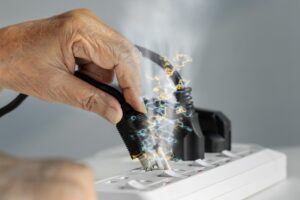How Does a Whole-House Surge Protector Work?
 One of the most common questions we get in regards to these systems is “How does a whole house surge protector work?” This is a valid question, especially since you’re probably used to seeing power strips and thinking that these are sufficient enough to protect your appliances and electronics from power surges.
One of the most common questions we get in regards to these systems is “How does a whole house surge protector work?” This is a valid question, especially since you’re probably used to seeing power strips and thinking that these are sufficient enough to protect your appliances and electronics from power surges.
First off, a whole-house surge protector is a device that is wired directly into your electrical panel, the main hub for all things electrical throughout your home. When there’s a voltage spike, otherwise known as a power surge, this device blocks or grounds the surge so that your appliances and electronics don’t get damaged.
Read on to learn more!
About Power Surges
What homeowners often don’t understand about power surges is that…
- They don’t just happen when there is a storm, they can happen any time a large appliance cycles on, or if too many appliances or lights are turned on at the same exact time.
- They don’t do all their damage right away … small power surges can slowly do damage to your home’s appliances and electronics over time.
What This Can Do
Power surges are capable of melting electric wiring, causing fuses to blow, and causing circuit breakers to trip. People tend to think of surge protection as storm protection, which, again, is not the case. Yes, power surges can and do happen during stormy weather, but lightning strikes causing a power surge strong enough to take out your appliances all in one fell swoop are rare.
The power surges you should be most concerned with come from inside the house.
When a powerful electrical appliance such as your air conditioner or central furnace cycles on, it can create an imbalance in the electrical current, creating those surges. For instance, have you ever noticed the lights in your home suddenly flickering when the air conditioner or the compressor kicks on? This is the result of a power surge.
Whole-house surge protection isn’t necessarily about stopping power surges altogether, but rather redirecting them so they can’t harm your appliances and electronics.
“What About Power Strips?”
Power strips are certainly a layer of protection that you can and should have for the electrical components in your home. They are safer than the older octopus plugs that people still use in their homes. You see, power strips contain their own circuit breakers, so if there is a voltage surge, the power strip will shut off power to prevent damage.
The problem is, this only protects the appliances and electronics connected to that power strip. So if your air conditioner sends a voltage spike throughout the entire home, your computer or entertainment center hooked up to the power strip may be safe, but the same can’t be said for your washer and dryer, your refrigerator, or even the lighting in your home. But we can help with the installation of a whole-house surge protector.
For quality electrical services and more throughout Southern Vermont, contact HB Energy Solutions today to request an estimate or schedule service!


Join Us Online